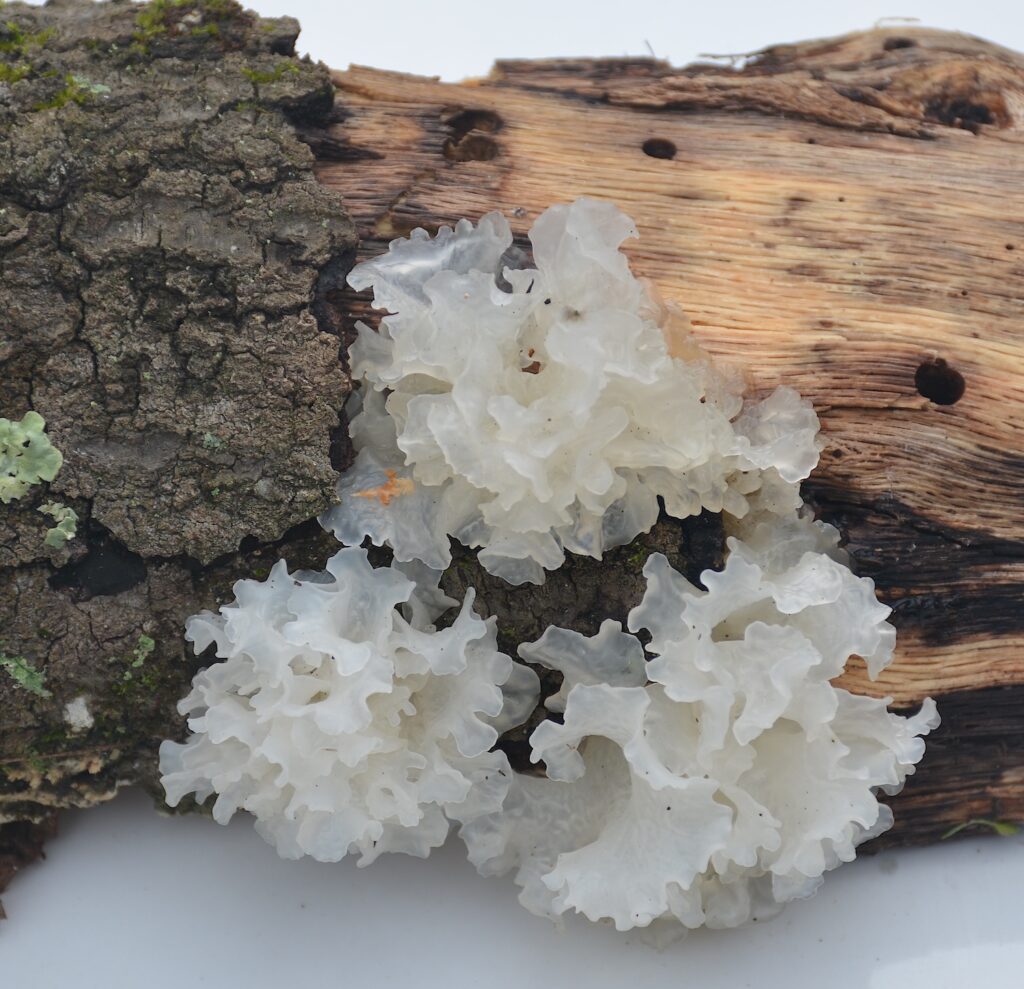
White Jelly Fungus, photo by Green Deane
Most mushrooms are eaten for their flavor, such as chanterelles. White Jelly fungus (Tremella fuciformis) above, has little to no flavor. So why eat it?
Chinese Research on mice in 2022, showed polysaccharides in Tremella regulate blood glucose and lipids affecting 84 genes associated with obesity, insulin resistance, and diabetic complications. Triglycerides, cholesterol, and fasting glucose were significantly lower in mice fed Tremella polysacchaarides versus a high fat diet. It is also a prebiotic and good for gut bacteria. A 2018 study published in Oncology Letters, researchers also found that Tremella polysaccharides have protective properties on the respiratory system. It significantly inhibited the onset of lung cell death caused by the toxic lipopolysaccharides of the Pseudomonas aeruginosa bacterium, which causes about 2,700 deaths in the United States annually, particularly among children.
The jiggly fungus is also used by cooks to deliver flavor. Many chefs dehydrate it then soak the fungus in a desired flavor making it a flavor bomb. It also adds a jelly-like texture to dishes. Jelly fungus has a lot of fiber and protein. A cup of it has 326 calories, less than a gram of fat, and is high in potassium, vitamin D varies on ho much sunshine it gets. Tremellas also has NFG, nerve growth factor and might used for treating neurogenative diseases. A two-month study found that consuming 600 or more milligrams of jelly fungus supplement daily improved short term memory. A rat study showed it significantly reversed drug-induced memory loss. Besides being dehydrated to carry flavor it can also be dried and powdered, which can be used smoothies, as a tea and a thickening agent. Freeze drying is the best method of dehydration. Jelly Fungus should not be collected where pesticides are used.
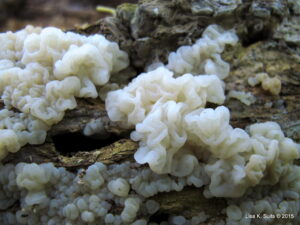
Non-edible Ductifera Pululahuana by Lisa K. Suits
Also called snow fungus, silver ear, snow ear, white wood ear, and white jelly mushroom, it is in the common in North America and Asia, and is often found on downed branches of hardwood, such as oak. Usually branches with the bark still attached. 164 grams of dried Jelly Fungus has 524 calories, 106 carbs, 65 grams et carbs, 41 grams fiber, 15 grams of protein, 1.8 grams of fat, 76 mg of sodium 59 mg of calcium, 6.5 mg of iron and 2,618 mg of potassium
Jelly fungus has one non-edible semi-look alike, Ductifera pululahuana, which grows on the ground as well as downed barkless branches. It is also much whiter than Tremellas, not translucent and more rounded and globular. I’ve always found it growing on bare hard packed ground. While Ductifera pululahuana, is considered not edible it is not known to be toxic, the non-edibility appears to stem from its quick degradation after being picked.
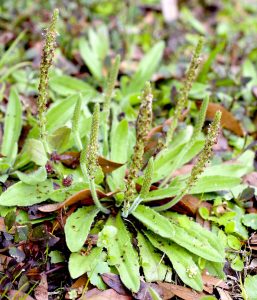
A native North American plantago, photo by Green Deane
There are Plantains that look like tough bananas and there are Plantains that are low and leafy plants. They are not related. Just two different groups with the same common name. Low-growing Plantains can be native or non-native. The one pictured left is native, the Dwarf Plantain, Plantago virginana, which we’ve been seeing much of lately. As a genus the plants are well-known. The leaves are edible raw when young. As they age they become more bitter and stringy. Cooking makes them palatable up to a point. Then they move into the astringent medical realm. As such they are used on bites, stings and to help puncture wounds heal. The seeds are edible once produced and are the source of the commercial dietary fiber, psyllium. When finely ground the seeds are sold under the brand name Metamucil. There are numerous species of Plantagos (Plantains) with at least five common locally, P. virginiana, P. major, P. lanceolata and P. rugelii the latter which strongly resembles P. major. They are all used the same way. (P. rugelii is pink at the base of the stem.) One problem beginning foragers have is confusing young Oakleaf Fleabane leaves for Dwarf Plantain leaves (they are both rosette-ish, low-growing green leaves, hairy with fibrous threads in the stem.) But the Dwarf Plantain is essentially a long skinny hairy leaf with a few teeth. The Oakleaf Fleabane is much fatter, has lobes, and does resemble oak leaves found on more northern species. You can read about the Plantains here and I have a video here.
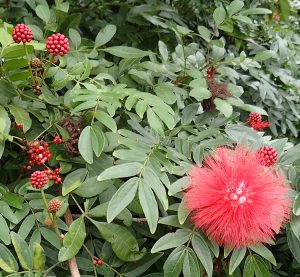
Calliandra haematocephala, the red powder puff. Photo by Green Deane
A toxic powder puff shrub we see this time of year is a native of Malaysia. It’s a small tree that was in the pea family but has been moved to the Mimosa group. It is not edible in any way. It’s just pretty, which has its own value. The name is slightly interesting in that it is all Living Greek mangled by new Dead Latin. Calliandra is a combination of Kallos (beautiful) and Andros (man) but is to mean — when poetically translated — “pretty stamen” (the male part of the flower which creates the powder puff.) Haematocephala means “blood head” or in this case “red head.” Thus pretty stamen red head. You could even stretch it to “pretty redheaded man.” The common name is Red Powder Puff.

Classes are held rain or shine or cold. (Hurricanes are an exception.) Photo by Kelly Fagan.
Foraging Classes: Because of weather there will be one foraging class this weekend, Saturday in West Palm Beach.
Saturday, January 20th, Dreher Park, 1200 Southern Blvd., West Palm Beach, 33405. 9 a.m. to noon. Meet just north of the science center.
Saturday, January 27th, Mead Garden, 1500 S. Denning Dr., Winter Park, FL 32789. Meet at the bathrooms, 9 a.m. to noon.
Sunday, January 28th, Eagle Lake Park, 1800 Keene Road, Largo, FL 33771. Meet at the pavilion near the dog park. 9 a.m. to noon
To read more about the classes, to pre-pay or sign up, go here.
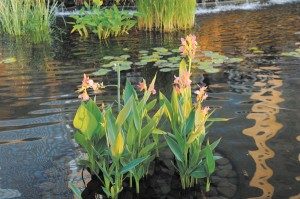
Canna can grow in a garden or a pond.
♣ Botany Builder #12. Do you remember the confusion in school over the words immigrant and emigrant? An emigrant is someone leaving a country, and an immigrant is someone entering a country. An emergent plant is one coming out of the water, such as Canna. It likes to grow in about a half a foot of water. It doesn’t like dry land and it doesn’t like deep water. It is emergent. Cattails are emergent, however some species of cattail — there aren’t that many — like to be close to shore and others like deeper water. What it really comes down to, can you get cattails from shore or do you need a canoe?
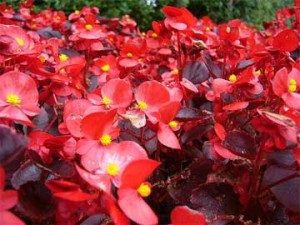
Begonia flavor varies with the color. Photo by Green Deane
This might be a good time to mention that Begonias are edible. We saw some this weekend at my foraging class. Unfortunately a rather popular book some 30 years ago said they are not edible. I actually spoke with the author once and she told me in subsequent editions that mistake would be changed but the book never went into second edition. Thus the mistake can be found on the internet. Begonias are not only the favorite of growers (and cemetery pots) they are naturalized locally. I see them often in damp spots such as stream banks or drainage ditches. The leaves are edible as well as the blossoms. They can be prepared in a variety of ways and the juice is also a vegetarian rennet. My favorite are wax begonias (and the flavor can vary with their color.) You can read about them here.
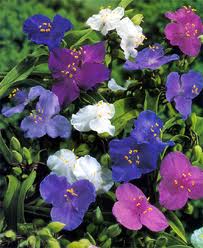
SPiderworts can be found in four colors, blue, pink, white and gray. Photo by Green Deane
Spiderworts got me in trouble once. I let them cover my entire lawn in suburbia. That prompted a visit from Lawn Enforcement Officers. I was cited in writing for having an unkept lawn which meant covered with weeds (that they were pretty, native was deemed irrelevant.) As I thought the citation wrong I read the pertinent law. It said a weed was a plant unintentionally over 18 inches high. Problem solved. My spiderworts were intentionally over 18-inches high. I watered and fertilized them. Consequently I beat the rap. And while Spiderworts favor the spring you can find them blossoming now here and there. Spiderworts are quite edible, at least all the parts above ground. They can be consumed raw, cooked or fermented. While this is not too descriptive they taste “green” to me, not distinctive but pleasant. If you ferment them into sauerkraut the stems and leaves are tough where as the blossoms are tender. Spiderworts have a history being connected to John Smith of Pocahontas fame. You can read about them here.

You get the USB, not the key.
172-video USB would be a good holiday present and is now $99. My nine-DVD set of 135 videos has been phased out. The USB videos are the same videos I have on You Tube. Some people like to have their own copy. The USB videos have to be copied to your computer to play. If you want to order the USB go to the DVD/USB order button on the top right of this page. That will take you to an order form. I’d like to thank all of you who ordered the DVD set over the years which required me to burn over 5,000 DVDs individually.

Green Deane Forum
Want to identify a plant? Perhaps you’re looking for a foraging reference? You might have a UFO, an Unidentified Flowering Object, you want identified. On the Green Deane Forum we — including Green Deane and others from around the world — chat about foraging all year. And it’s not just about
warm-weather plants or just North American flora. Many nations share common weeds so there’s a lot to talk. There’s also more than weeds. The reference section has information for foraging around the world. There are also articles on food preservation, and forgotten skills from making bows to fermenting food.
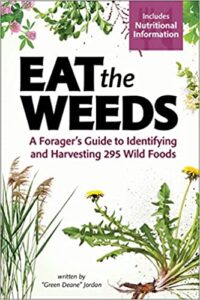 Now in print is EatTheWeeds, the book. It has 274 plants, 367 pages, index, nutrition charts and color photos. Several hundred were pre-ordered on Amazon. Most of the entries include a nutritional profile and if no profile reported then noteworthy constituents. I have no doubt that the book will outlive me, my little contribution to posterity.
Now in print is EatTheWeeds, the book. It has 274 plants, 367 pages, index, nutrition charts and color photos. Several hundred were pre-ordered on Amazon. Most of the entries include a nutritional profile and if no profile reported then noteworthy constituents. I have no doubt that the book will outlive me, my little contribution to posterity.
This is weekly newsletter #584. If you want to subscribe to this free newsletter you can find the sign-up form in the menu at the top of the page.

